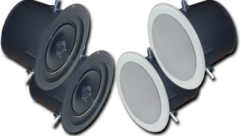Speech Intelligibility In Design
If music reproduction drives the sound system design process, the cart is before the horse.
THE ORIGINAL PURPOSE of sound reinforcement was to deliver the spoken word to large groups of people. The design and installation of early systems was an engineering endeavor with objective performance criteria. Much research was done to quantify the requirements for intelligible speech with regard to the sound system and the auditorium’s acoustics. Textbooks were written early in the last century that contained the necessary math and physics tools for attaining accurate speech reproduction in rooms of all types. Certainly the practitioners of that day expected others to build on their foundation. Surely the performance of speech systems would steadily improve with time. The eventual result would be excellent speech intelligibility (SI) in venues of all types.
Unfortunately, this hasn’t been the case. Poor SI in public spaces is the norm rather than the exception. It’s rare to be able to understand an announcement anywhere without having to strain the ear. It seems that the ground work laid by the audio fathers has been forgotten. We live in an age of amazing signal processing power, yet SI in spaces of all types continues to decline. There are some simple reasons for this.
Most people hone their listening skills in small, acoustically-friendly rooms with relatively low noise floors. This doesn’t prepare one to work in large spaces. You can get away with murder regarding loudspeaker selection and placement in a small room. The different choices simply produce different tonal colorations. Without an objective reference, anything goes. This isn’t even remotely true in a large space. Here, if you make the wrong choices, the audience won’t understand the words. And all of the equalizers in the world won’t fix it. SI shouldn’t be confused with high fidelity. A system can sound good and be unintelligible, and a system can be intelligible and not sound good. Although this seems like a contradiction, it’s true.
One can produce high levels of sound without a math and physics background. The results are usually subjectively evaluated with music as a program source and the human hearing system as the only instrument. This design approach has clouded the division between sound system engineering and music reproduction as an art form. While there’s a place for both, we must remember that they’re two completely different things. Anyone can crank up a PA system, but it takes a professional to design one that’s intelligible.
It’s a fact that physical systems tend to go from order to disorder. This is called entropy, and examples of it abound. We can always take an orderly system and create disorder, but the reverse isn’t as simple. You can’t unscramble eggs. Intelligible speech requires a greater degree of order than a music system. If the sound system design is driven by artistic, subjective criteria, it may do a poor job of delivering speech information to the audience.
Sound systems should be designed for speech, and then adapted for music playback. The required sound system attributes for SI are quantifiable and measurable. Manipulating them is an engineering exercise. It’s science, rather than art. Music reproduction can be a world of “anything goes,” but intelligible systems have objective criteria. The best way to exclude the novice from designing a sound system is to require that a minimum SI score be met for all listener seats. Because SI is science, you don’t have to worry about upstarts in the field stealing projects from you. Competence in improving SI requires one to hit the books. Mastery of the Hopkins-Stryker relationships is mandatory, as well as expertise in acoustic measurements and computer-based room modeling.
Music reproduction is a very important part of what many sound systems are expected to do, but it has become a sort of pollution to the design process. The objective performance criteria of high-quality speech systems have gradually given way to the subjective criteria that drive music systems. Today it’s common for the customer to specify the loudspeaker type and placement because they’ve heard and seen a similar system that sounds good with music and provides visual appeal.
One of the biggest “sleepers” in the world of sound reinforcement is the high Q point-source. Once associated only with stadium or paging horns, modern high Q devices have extended bandwidth and excellent sonic quality. A well-designed coaxial horn can have smooth, consistent polars over its entire bandwidth with a smoother response than many hi-fi loudspeakers.
Highly directional loudspeakers generally improve SI, but many designers consider them to be “unmusical.” There’s no factual basis for this assertion. In fact, many designers tout the sound quality of line arrays, and these are among the most directional of all loudspeakers. Movie theaters are considered by most to have high-quality sound, and the device of choice in these venues is the large format horn. Even so, the stigma persists that high Q means bad sound.
It seems that music reproduction has had too much influence over the design of sound reinforcement systems for large spaces. Speech reproduction has been an afterthought, and the perception that “if the music sounds good, so will the speech” has prevailed. We now see evidence of the pendulum swinging the other way.
Speech Intelligibility In Design
If music reproduction drives the sound system design process, the cart is before the horse.
SI is becoming law. It already is in Europe. Sound reinforcement systems in public spaces must meet a minimum Speech Transmission Index (STI) score for public safety reasons. The rating method isn’t perfect, but it’s vastly better than nothing at all. The legal aspects of SI mean that architects must consider room acoustics as part of a building design. Buildings must not only be aesthetically pleasing, but also be acoustically tolerable.
The requirements for good SI are basic and straight-forward. It’s all about ratios. The system must have adequate bandwidth, adequate signal-to-noise ratio, adequate direct-to-reverberant ratio, and be devoid of interfering reflections. Each of these conditions can be quantified by measurement. The relationships between them are well understood, which means that improvements in SI can be predicted in advance and verified once they’re implemented. SI is subject to the laws of physics. There’s a cause and effect relationship between the relevant parameters and their effect on the end results.
Music generally makes a poor choice for judging the accuracy of a sound system. This is because the music itself is a form of art with no objective right or wrong attributes. This is why I always initially evaluate the performance of a sound system with speech as a program source. Humans are calibrated regarding speech. If something is wrong, the brain will know it. Music is subjective, while SI is objective. It can be measured and graded, requiring expertise and special equipment on the part of the investigator.
If you’re a contractor or consultant who has invested significant resources into learning audio and acoustics, you should go one step further and learn to market speech intelligibility as a product. SI means job security. There are precious few experts in this arena. You can’t import it from China or buy it on eBay or at a warehouse store. It doesn’t go to the low bidder, and the electrical or IT contractor doesn’t want to be bothered with it. There aren’t any magic processors that fix bad rooms and poor loudspeaker choices. Methods that improve SI in one venue may be ineffective in another. SI is like a custom suit that must be tailored to fit the wearer. And there will always be a need for good tailors.
The professional audio and AV industries would gain credibility as an engineering field if SI were pushed to the front of the sound system design process. Sound systems that are highly intelligible provide a strong foundation for high-clarity music reproduction. We only need to add channels and extend the bandwidth to render a good speech system capable of excellent music reproduction. Order to disorder — it’s a one-way street.
Pat Brown is president of Synergetic Audio Concepts (Syn-Aud-Con) Inc. and Electro-Acoustic Testing Company (ETC) Inc. Syn-Aud-Con conducts training seminars in audio and acoustics worldwide for those who operate, install, and design sound reinforcement systems. ETC Inc. performs precision loudspeaker testing for the audio industry. He can be reached at [email protected].










